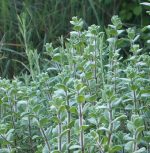 Also known as bible hyssop, Syrian oregano, and Lebanese oregano, this tender perennial herb is native to the Middle East and is a member of the deadnettle family, Lamiaceae, that also includes mint, basil and Salvia. The bushy plants grow up to 3′ tall and have hairy square stems with oblong to ovate, gray-green leaves that are up to 1″ long, aromatic and softly hairy. From late spring to summer, spike-like clusters of tiny white to pale pink appear. Each flower is two-lipped, tubular, and subtended by gray-green bracts. Photo Credit Wikipedia
Also known as bible hyssop, Syrian oregano, and Lebanese oregano, this tender perennial herb is native to the Middle East and is a member of the deadnettle family, Lamiaceae, that also includes mint, basil and Salvia. The bushy plants grow up to 3′ tall and have hairy square stems with oblong to ovate, gray-green leaves that are up to 1″ long, aromatic and softly hairy. From late spring to summer, spike-like clusters of tiny white to pale pink appear. Each flower is two-lipped, tubular, and subtended by gray-green bracts. Photo Credit Wikipedia
The Hebrew word אֵז֗וֹב (ezob or ezov) is usually translated hyssop but has been identifid as several different plants including common caper, whorled savory, sorghum, wall rue, maidenhair spleenwort, and Syrian marjoram. All of these plants fit some of the contexts in which they appear but not all. It is probable, therefore, that there is no single plant that will suit all the passages. The following passages are most likely to be Syrian marjoram because it fits the contexts: first because bunches of the hairy branches of the plant together with the leaves and flowers woud serve well as the sprinklers (Exodus 12:2, Leviticus 14: 4,6,52, Numbers 19: 6,18. Psalms 51:7, and Hebrews 9:19); and second, marjoram is common growing growing among rocks and on terrace walls (I Kings 4:33).
Exodus 12:22 (NIV) Moses tells the elders how to lead the people in the observance of Passover.
“Take a bunch of hyssop, dip it into the blood in the basin and put some of the blood on the top and on both sides of the doorframe. None of you shall go out of the door of your house until morning.”
Leviticus 14 (NIV) God tells Moses how the priests are to deal with cleansing lepers and their abodes.
4.” the priest shall order that two live clean birds and some cedar wood, scarlet yarn and hyssop be brought for the person to be cleansed. ”
6. “He is then to take the live bird and dip it, together with the cedar wood, the scarlet yarn and the hyssop, into the blood of the bird that was killed over the fresh water.”
52. “He shall purify the house w”ith the bird’s blood, the fresh water, the live bird, the cedar wood, the hyssop and the scarlet yarn.”
Numbers 19 (NIV) God lays out the laws of purifcation to Moses and Aaron.
6. “The priest is to take some cedar wood, hyssop and scarlet wool and throw them onto the burning heifer.”
18. “Then a man who is ceremonially clean is to take some hyssop, dip it in the water and sprinkle the tent and all the furnishings and the people who were there. He must also sprinkle anyone who has touched a human bone or a grave or anyone who has been killed or anyone who has died a natural death.”
I Kings 4:33 (NIV) Solomon’s knowledge of science and nature is described.
“He spoke about plant life, from the cedar of Lebanon to the hyssop that grows out of walls. He also spoke about animals and birds, reptiles and fish.”
Psalms 51:7 (NIV) King David prays for restoration.
“Cleanse me with “hyssop, and I will be clean; wash me, and I will be whiter than snow.
Hebrews 9:19 (NIV) Moses’ actions in the old covenant are described.
“When Moses had proclaimed every command of the law to all the people, he took the blood of calves, together with water, scarlet wool and branches of hyssop, and sprinkled the scroll and all the people.”
Syrian marjoram likes full sun and average, dry to medium moist, well-drained, neutral to alkaline soil in USDA Hardiness Zones 9-10, and is heat and drought tolerant. Plants are generally healthy but are susceptible to damage by aphids and leafhoppers. Propagation is by seed and basal cuttings. Plants should be cut back before the flowers appear to promote bushiness and cut to the ground in autumn, winter, or early spring before new growth appears. Syrian marjoram is attractive and the dried crushed leaves are especially valued for making the Middle Eastern spice zaa’tar, by combining them with ground sumac berries, sesame seeds, and salt and pepper. Dried leaves may also be used in potpourris. Plants are a good choice for an herb garden and do well in containers.
The genus name, Origanum, may come from the Greek words oros, meaning mountain, and gamos meaning beauty. The specific epithet, syriacum, is the Latinized form of Syria, a country where the plant is native.